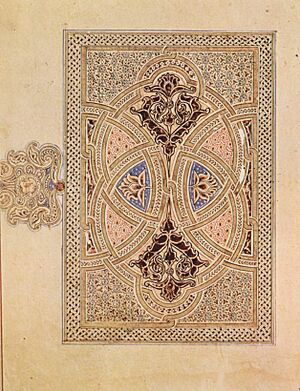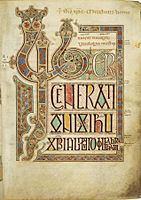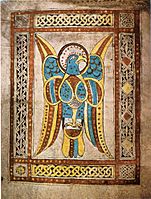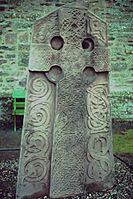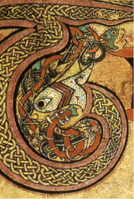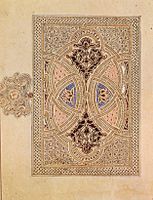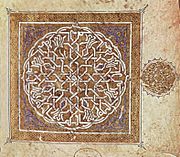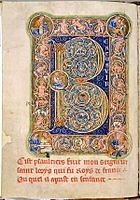Interlace (art) facts for kids
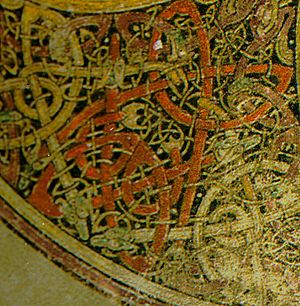
Interlace is a cool type of decoration seen in medieval art. Imagine ribbons or other shapes that are looped, braided, and knotted together. These patterns often fill up a space with complex designs.
You can find interlace in art from different places and times. It was popular in Northern Europe during the Migration Period, in early medieval Insular art from Ireland and the British Isles, and in Norse art. It's also a big part of Islamic art.
These fancy braided patterns first showed up in late Roman art. You could see them on mosaic floors and other artworks across Europe. Later, in the 400s and 500s, Christian Egypt's Coptic art used similar ribbon interlace. These designs looked a lot like the early knotwork found in old books from Ireland and the British Isles.
Contents
History and Where It Was Used
Interlace in Northern Europe
Interlace is a main feature of "Style II" animal style decoration. This art style was common during the Migration Period across Northern Europe. It even traveled with the Lombards to Northern Italy. Often, the long "ribbons" in these patterns would end with an animal's head.
Around the year 700, interlace became less common in most of Europe. But it kept growing in the British Isles and Scandinavia. Here, you can find it on metalwork, wood carvings, runestones, tall high crosses, and illuminated manuscripts. These artworks date from the 600s to the 1100s.
Early Insular knotwork, like in the 600s Book of Durrow, often looks like "broken and rejoined" braids. It's not clear if these patterns came directly from Egypt to Irish monasteries. They might have come through Italy instead.
A new style appeared around the mid-600s. It showed long, thin animals twisted into balanced shapes. You can see examples in the Sutton Hoo treasure. The most detailed animal interlace is in Viking Age art. This is especially true in the Urnes style (before 1050). Here, plant designs twist together with the animals.
The best interlace in Northern Europe was in the Insular art of the British Isles. Here, animal styles mixed with ribbon knotwork and Christian ideas. Famous examples include the Book of Kells and the Cross of Cong. Entire "carpet pages" in books were filled with abstract patterns, using lots of interlace. Stone high crosses also combined interlace panels with pictures of people or stories.
Insular interlace was copied in other parts of Europe. The Franco-Saxon school (700s to 1000s) copied it closely. Other Carolingian art schools used it less, preferring plant-like decorations. In Romanesque art, these plant forms became typical. Interlace became much simpler, though some animal shapes were still used.
Interlace in Islamic Art
Geometric interlace patterns are very common in Islamic art. They are a special kind of arabesque. Early Umayyad architecture (700s to 900s) used interlace. You can see it in floor mosaics, window grilles, carvings, and metalwork. Later, more complex interlace became common in medieval Islamic art. Interlaced designs are also found in Kufic calligraphy (fancy writing).
Interlace in Southern Europe
Interlace and knotwork are often seen in Byzantine art. This continued the Roman tradition. However, it wasn't as important as in other regions. One special example is the Croatian wattle or "three-ribbon interlace." This was used in early medieval Croatia on stone carvings from the 800s to 1000s.
Interlace was also widely used in Serbia. This was during the Morava architectural school from the 1300s to 1400s. It appeared on and inside churches and monasteries. You can also find it in religious books from that time.
In Romania, interlace is an important decoration in Brâncovenesc architecture. This style grew in the late 1600s and early 1700s. Later, in the late 1800s and early 1900s, it was used again in Romanian Revival architecture.
Gallery
-
Insular animal and knot interlace, Lindisfarne Gospels, early 8th century
-
Page from the Book of Dimma with simple interlace borders, 8th century
-
Ärentuna runestone with interlaced animal, Uppland, Sweden
-
Detail of decorated initial "T" with ribbon interlace filling and interlaced animal motif, Book of Kells, c. 800
-
Carpet page from an 11th century Arabic illuminated manuscript
-
Folio from a manuscript of the Qur'an with interlaced border, 1182
-
Romanesque interlace, "inhabited" with figures, Northern England, 1190-1200



